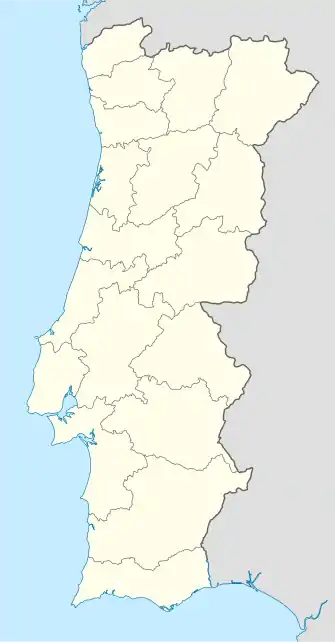Vidago (União das Freguesias de Vidago, Arcossó, Selhariz e Vilarinho das Paranheiras)
Vidago (União das Freguesias de Vidago, Arcossó, Selhariz e Vilarinho das Paranheiras) ist eine portugiesische Gemeinde (Freguesia) im Kreis (Concelho) Chaves im Norden Portugals.
| Vidago, Arcossó, Selhariz e Vilarinho das Paranheiras | ||||||
|---|---|---|---|---|---|---|
| ||||||
| Basisdaten | ||||||
| Region: | Norte | |||||
| Unterregion: | Alto Tâmega | |||||
| Distrikt: | Vila Real | |||||
| Concelho: | Chaves | |||||
| Koordinaten: | 41° 39′ N, 7° 34′ W | |||||
| Einwohner: | 1991 (Stand: 30. Juni 2011)[1] | |||||
| Fläche: | 24,57 km² (Stand: 1. Januar 2010)[2] | |||||
| Bevölkerungsdichte: | 81 Einwohner pro km² | |||||
| Postleitzahl: | 5425–999 | |||||
| Politik | ||||||
| Bürgermeister: | Rui Manuel Branco Rodrigues | |||||
| Adresse der Gemeindeverwaltung: | Junta de Freguesia de Vidago, Arcossó, Selhariz e Vilarinho das Paranheiras Largo Miguel Carvalho, n.º 21 Vidago | |||||
Geschichte
Die Gemeinde entstand im Zuge der Gebietsreform vom 29. September 2013 durch die Zusammenlegung der ehemaligen Gemeinden Vidago, Arcossó, Selhariz und Vilarinho das Paranheiras.[3]
Vidago wurde Sitz der neuen Verwaltung.
Demographie
| Freguesia | ehemalige Freguesias | ||||||
|---|---|---|---|---|---|---|---|
| Wappen | Freguesia | Einwohner[4] | Fläche in (km²)[5] | Wappen | Freguesia | Einwohner[6] | Fläche in (km²)[7] |
| Vidago, Arcossó, Selhariz e Vilarinho das Paranheiras | 1991 | 24,57 | Vidago | 1204 | 6,39 | ||
| Arcossó | 325 | 7,95 | |||||
| Selhariz | 244 | 5,69 | |||||
| Vilarinho das Paranheiras | 220 | 4,55 | |||||
Einzelnachweise
- www.ine.pt – Indikator Resident population by Place of residence and Sex; Decennial in der Datenbank des Instituto Nacional de Estatística
- Übersicht über Code-Zuordnungen von Freguesias auf epp.eurostat.ec.europa.eu
- Diário da República, 1.ª série — N.º 19 — 28 de janeiro de 2013. (PDF; 2,3 MB) Diário da República eletrónico, abgerufen am 11. Juli 2019 (portugiesisch).
- Stand 30. Juni 2011
- Korrespondenztabelle LAU – NUTS 2016, EU-28 and EFTA / verfügbare Kandidatenländer. (xlsx) Eurostat, 2018, abgerufen am 11. Juli 2019 (englisch).
- Stand 30. Juni 2011
- Korrespondenztabelle LAU 2 – NUTS 2013 /NUTS 2010, EU-28. (xlsx) Eurostat, 2013, abgerufen am 11. Juli 2019 (englisch).
Weblinks
- Portal das Freguesias – Vidago (União das Freguesias de Vidago, Arcossó, Selhariz e Vilarinho das Paranheiras). Abgerufen am 11. Juli 2019 (portugiesisch).
This article is issued from Wikipedia. The text is licensed under Creative Commons - Attribution - Sharealike. The authors of the article are listed here. Additional terms may apply for the media files, click on images to show image meta data.


